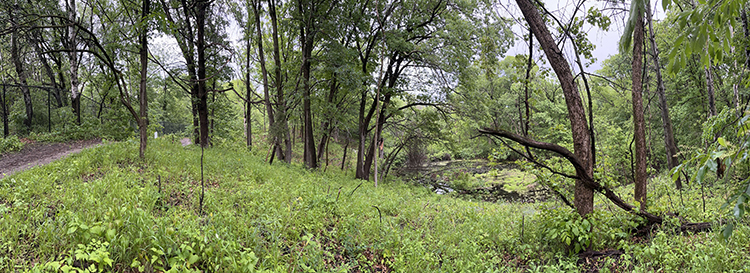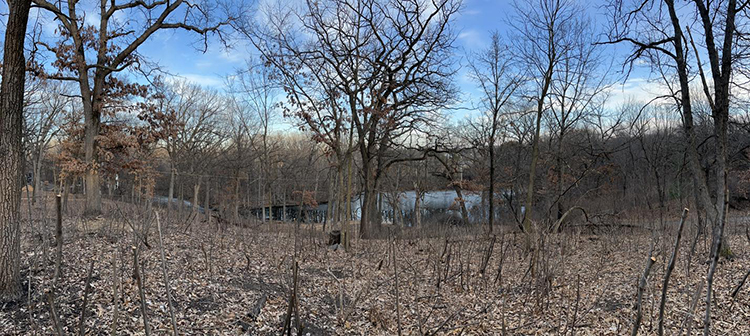Friends of the Wildflower Garden

These short articles are written to highlight the connections of the plants, history and lore of the Eloise Butler Wildflower Garden with different time frames or outside connections and usually include personal commentary of the writer, not necessarily related to the Wildflower Garden. A web of present and past events.
August 2025
It is mid-August. The goldfinches are on the hyssops and catmint for the fresh green seeds, the butterflies flitter from Joe-Pye weed to monarda to phlox to coneflowers with swallowtails outnumbering monarchs 4 to 1. Rabbits, which are in abundance this year, have had exceptional choices to dine upon, but still seem to prefer gray-headed coneflower, orange coneflower, bluejacket and any type of lily they can find. Young white-tails seem to have no fear of wandering around in daylight this year but the turkeys still watch for cars before they cross the streets. Quite a summer.
August articles
Eloise and Martha have a dismal August
Bird treats from an overlooked plant
Eloise and Martha had a dismal August - history in 25 year slices.
As summer begins to make the transition into autumn, with our gardens in the metro area amply supplied with rainfall and sunlight, we note opposite situations in earlier years.

Eloise Butler wrote 100 years ago:
“Through August and not yet fairly broken the most protracted drought ever recorded in Minnesota. The hillsides in the Reserve have suffered severely but the asters are holding their own fairly well. The usual crop of mushroom is a complete failure.”
"Have had some pleasant outing to break general dismalness. Went out on the prairies early in July when the wood lily mingled with the tall cream-colored spikes of zygadene (1) at its height, and on the low lands, large masses of showy moccasin flowers disported themselves. In August, spent two days at Lake Kabecona [Kabekona], about twenty miles east of Itasca Park. There I saw for the first time in their native haunts the spurred gentian and the northern grass of parnassus. On a creek floated the pretty white water crowfoot in full blossom, and all the land was blue with harebells."(2)
Contrast that to Martha Crone’s situation 25 years later. Her notes state that late August was cold: “Aug. 20: Heavy frost, altho some Sensitive Ferns were the only plants destroyed here. Aug. 28: Cold rain all day - fire in stove entire day.” (3)
We should appreciate what we have this year!
Later history.
Fifty years ago: We reported back in the April Twigs about the how the garden path from the front gate to the shelter came about 50 years ago. August 1975 was the month it was done. Friends president Moana Beim and vice-president Alex Dean met with Parks Superintendent Robert Ruhe about the path project and received approval to do it. He later wrote to reassure the Friends “of our appreciation for the volunteer efforts you have historically given to this area.”

Twenty five years ago: The stonework around the new back gate, following some re-work from 1997 to this year, was finally competed in June 2000 and the Friends paid the Park Board the final cost of $2,034. The new back gate project had started in 1995.
Notes:
(1) Zygadene is an older reference to species of the genus Zigadenus. All but one of the species formerly in Zigadenus have been recently transferred to other genus. The species covered here is now in Anticlea.
(2) "The Wild Garden in 1925" - a submission to the Gray Memorial Botanical Chapter, (Division D) of the Agassiz Association for inclusion in the members circular.
(3) Martha Crone's Garden Log - 1950.
Plants of the Kabekona visit.
It is worth noting some detail on the plants that Eloise mentioned seeing “in their native haunts” on her trip to Lake Kabekona. These were three species that Eloise planted in her native plant reserve to demonstrate the flora of the state. All three have special habitat requirements and none of three survived into the current century despite some repeated attempts to adapt them to the area.
The spurred gentian (Halenia deflexa) in native to only 17 counties in Minnesota, mostly northern. The flowers, purple to green, are in groups of 2 to 9. Each of the 4 petals has a spur extending backward, hence the name. She brought back 4 plants which she put into the north meadow. Eloise had acquired her first clump of this plant in July from Grand Marais MN, marking the first year of its appearance in the Garden.
Her next plant, northern grass of parnassus (Parnassia palustris) is also a species of the northern half of the state, inhabiting wet meadows. Nine clumps with into the north meadow. It was first planted in 1924 in the Garden and also in three later years of Eloise’s tenure. Then Ken Avery made the last attempt to grow it in 1962. This species is found worldwide in the northern zones of both the east and west hemisphere. It is not a grass but acquired that name as the Greeks let their cows browse on it on the slopes of Mt. Parnassus. Each stem bears a single white veined flower that is quite striking. Five fertile stamens alternate with 5 sterile stamens, each of which has up to nine yellow-tipped glands rising from it to attract pollinators.


Eloise also obtained 2 clumps of the white water crowfoot (Ranunculus aquatilis) and they went into the Garden pool. She had previously tried it in 1916. By 1925 her pool of open water in the Garden was very shady and the plant probably did not survive long. This plant is actually quite common in Minnesota today, found in most counties.
Below: White water crowfoot, Ranunculus aquatilis var. diffusus, photo USFS.


Twenty five years later on July 15 1950, Martha Crone who was also familiar with the haunts of northern Minnesota sourced from Deer River MN, 24 of the exquisite dragon’s mouth orchid, Arethusa bulbosa. What a sight this must have made in the Garden. It is native to only 15 counties in Minnesota, mostly in the wetlands of the northern half of the state. This is sole member of the genus Arethusa in North America.
Martha wrote about it in her annual report to the Park Board saying it had never been in the Garden before, forgetting that she previously planted it in 1935, collected up on the Gunflint Trail. Eloise Butler was first in planting it back in 1929 and ’30. It survived for a number of years but is no longer extant as the Garden habitat, even though a peaty wetland, it was not the right match for this plant.
FIPAG has a new name
The Friends Invasive Plant Action Group (FIPAG) was officially formed in 2007 with the leadership and industriousness of Jim Proctor. The purpose of the group was to protect the Garden itself from the influx of invasives from the buffer zone around the Wildflower Garden.
It has now been announced that the Volunteer Stewardship Area (the old buffer zone) which surrounds the Eloise Butler Wildflower Garden has been renamed "The Greater Eloise Volunteer Stewardship Area." Improving the natural habitat in this area which buffers the Wildflower Garden has been the focus of the Friends Invasive Plant Action Group (FIPAG) since 2007. In accord with the renamed area, FIPAG volunteers will now be called "Greater Eloise Stewards.”
The Greater Eloise Stewards have been busy every month this year primarily east and southeast of the Wildflower Garden, clearing buckthorn, garlic mustard, planting, protecting the slopes with wattles and controlling new buckthorn growth.
The photo below shows the development of the area tentatively named “Anwatin savanna,” near a large pond with all the non-native woody plants removed or cutback for further treatment. Seeds of dozens of species that were spread in the fall and over the winter have germinated on the green slopes

Above: Summer 2025 panoramic photo of the area. [Larger photo] Below: A spring 2025 view of the work area showing the work done during the winter months with a clear view of the pond. Photos Jim Proctor.

Bird treats from an overlooked plant
One of the advantages given the writer is having some space to grow native plants and to see the variation that can occur from year to year and location to location. This past summer of exceptional rainfall has produced many vigorous plants but American Spikenard has been a true wonder.

American Spikenard [Aralia racemosa] is a species many overlook when choosing what to plant, especially for semi shaded areas, and I say that because you rarely see it in gardens. It is not a plant for a tight space however as its stems have some of the largest leaves of any North American herbaceous plant. The leaf is compound with 3 main divisions, each division having 9 to 21 leaflets, each leaflet being 2 to 4 inches long - that’s a big leaf! When grown in full shade the plant will flower but never reaches full potential. Neither does in like full sun. The happy point is partial sun for 2 to 4 hours per day.
Normally the plant height reaches 4 feet if it has some sun. This year was amazing. The plentitude of moisture this summer and the warm temperatures have produced a 7 foot high multi-stemmed wonder, with many clusters of flowers, which while not spectacular, produce a feast for our feathered friends. Those dense flower clusters turn into dark purple berries which the birds never let go to waste. The berries are aromatic but not too palatable to humans unless cooked, so the birds get them.
The plant grows from a deep taproot, so it is best not to try to move a plant once established. The root was used in native medicines.

Links to an information sheet on this plant:
Historical Photo
A view of cardinal flower and boneset in the wetland, from a Kodachrome by Martha Crone on August 4, 1948. Photo ©Friends of the Wildflower Garden.

*Photo note: Photos with a “CC” credit are used for educational purposes under Creative Commons license. Photos without credit are by G D Bebeau and may be used for educational purposes under Creative Commons license CC BY-SA 3.0. Learn about this at https://creativecommons.org/share-your-work/cclicenses/
All selections published in 2025
All selections published in 2024
All selections published in 2023